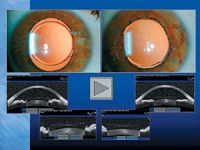Article
Phakic IOL maintains benefits of PMMA version
Chicago—The foldable version of the iris claw fixated myopic phakic IOL (Artiflex II/Veriflex, Ophtec/AMO) affords faster recovery of excellent uncorrected visual acuity (UCVA) compared with the polymethylmethacrylate (PMMA) model (Artisan/Verisyse, Ophtec, AMO), but otherwise has the same favorable efficacy and safety profile associated with its widely used predecessor, according to results of a prospective, intrapatient comparison study reported by Jose L. Guell, MD, PhD, at the subspecialty day meeting sponsored by the International Society of Refractive Surgery of the American Academy of Ophthalmology.

"Experience with the foldable iris claw IOL has been very encouraging so far," said Dr. Guell, professor of ophthalmology, Universidad Autonoma de Barcelona, and director, cornea and refractive surgery unit, Instituto de Microcirugia Ocular de Barcelona, Spain. "Certainly, longer-term data are needed to establish its safety definitively, but based on its advantages, which include the benefits of small-incision surgery, its location deep in the anterior chamber, and opportunity for long-term stable centration, we consider this technology the best phakic IOL implant today and for future applications."
The foldable iris claw phakic IOL is constructed of silicone and is implanted and enclavated with a technique similar to that used for the PMMA version except that it can be introduced through a 2.5- to 3-mm incision. The comparative study enrolled 59 patients who were operated on by two surgeons: Dr. Guell and Francoise Malecaze, MD, PhD, Toulouse, France. Of that population, 37 patients had completed 12 months of follow-up, and Dr. Guell had seen 11 of his patients at 24 months postimplantation.
The results showed that at 1 week after surgery, mean UCVA was superior in the eyes with the foldable IOL compared with eyes with the PMMA version implanted, 0.63 versus 0.35. UCVA for the eyes with the foldable implant remained stable throughout follow-up, but improved in eyes that received the PMMA implant and was similar in both groups at 24 months.

"The difference favoring the foldable version is possibly due to an improved formula for power calculation," Dr. Guell said.
The efficacy index (mean postoperative UCVA/mean preoperative best spectacle-corrected visual acuity [BSCVA]) was slightly better at follow-up visits throughout the first year for the foldable implant (range, 0.82 to 0.86) compared with the original PMMA version (range, 0.65 to 0.76). For the eyes seen at 24 months, the mean efficacy index values were 0.86 for the PMMA IOL compared with 0.75 for the silicone implant.
Newsletter
Don’t miss out—get Ophthalmology Times updates on the latest clinical advancements and expert interviews, straight to your inbox.





